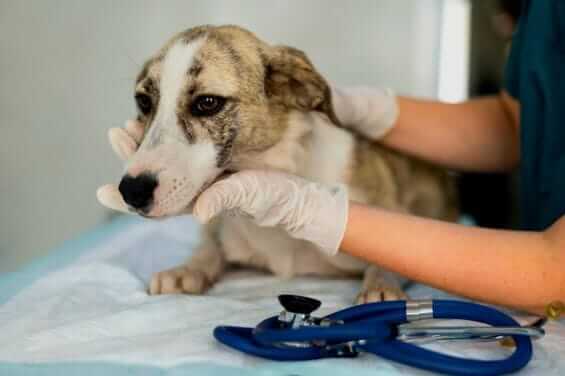You are seeing Blood in the poop of your dog and wondering what is going on. It can be a very disturbing and stressful experience for you. Bloody stool in a dog is a very concerning issue. If you see blood in the poop of your dog, do not ignore it. Blood in the stool of a dog is a clear sign that there is something wrong with the digestive system of your beloved dog.
In this article, we will dive deep into all the aspects of bloody stool in a dog. We will explore what causes blood in stool in dogs. We will discuss its treatment as well. So, stay tuned!
Common Causes of Bloody Stool In A Dog
Bloody stool in dogs can be very alarming. Let’s discuss what causes blood in stool in dogs:
Red Colored Food:
Dogs love to eat different foods. Sometimes they eat colored foods such as beetroot, tomatoes, and red berries that make their food red in color and you might mistaken it as blood.
Infection in the intestines:
Sometimes the bacteria and the protozoan that are present in the intestines of the dog cause irritation and inflammation in them. The irritation cause soreness and blisters in intestines or stomach which make the intestines bleed and results in blood in poop.

Inflammatory Bowel Disease (IBD):
There is a chronic disease called “Inflammatory Bowel Disease (IBD)” in dogs. This disease causes inflammation and soreness in the intestines that cause bloody diarrhea in dog stool.
Hemorrhagic Gastroenteritis (HGE):
Hemorrhagic Gastroenteritis (HGE) is a disease that causes vomiting and bloody diarrhea in dog stool. This disease mostly affects small breeds.
Changes in diet:
Sometimes changes in diet cause allergies that cause tears in the intestines that cause blood in dogs’ stool.
Trauma or Injury:
Physical trauma or ingestion of harmful such as plastic objects or needle objects can result in bleeding within the digestive system.
Tumors or Polyps:
Benign or malignant growths in the colon or rectum can lead to bloody stool. This disease is more commonly seen in older dogs.
What Does Blood In A Dog Poop Looks Like?
The blood in the poop of the dog can be different in color. It helps to find out the place in the intestine that is bleeding.
Hematochezia (Bright Red Blood in a Dog’s Poop):
The term “hematochezia” describes a condition where bright red blood is present in a dog’s poop. This type of blood in the stool is mostly bright red. It indicates that it originates from the lower part of the digestive tract, which includes the colon, anus, and rectum. It appears fresh and hasn’t undergone the full digestive process.
When hematochezia occurs it causes diarrhea. Dogs poop several times and in larger quantities. The color of the stool is red. The consistency of stool can be soft and liquid.
Melena (Black and Tarry Poop):
In this condition, the color of the blood can be black or tarry. The black color of poop indicates blood has undergone through digestion and that means there is a problem in the upper part of the digestive tract that includes small intestines and stomach.
Melena in dogs causes severe problems such as
- Ulcer
- Inflammation
- Cancer
In melena, the consistency of poop can be hard.
Pure Blood in Dog Stool

In certain instances, you may observe your dog passing pure blood with no accompanying stool. This can occur when the stool is liquid or when the gastrointestinal tract is empty, leading to only blood being expelled. Dogs might show some other signs of sickness such as lethargy, vomiting loss of appetite, etc.
Sometimes it happens that there is bright red blood in dog stool but he might acting normal and not show any signs of sickness. It could indicate that the dog blood in stool is a result of a recent injury that happened in the lower region of the gastrointestinal tract.
Bloody Stool in Dogs and Vomiting:
Sometimes, blood in the stool may be accompanied by vomiting. This combination can indicate a more severe condition. If your dog is both vomiting and passing blood in their stool, it’s crucial to see a veterinarian as soon as possible. The combined loss of fluids through vomiting and blood in the stool can lead to severe dehydration, which can be life-threatening.
Bloody Diarrhea in Dogs Without Vomiting:
However, if your dog has bloody diarrhea but is not vomiting, this could indicate a major problem. While it may not be as urgent as when vomiting is involved. It is critical to visit your veterinarian as soon as possible.
What Are Other Symptoms To Look For
Aside from bloody stools, keep an eye out for the following symptoms:
- Diarrhea
- Vomiting
- Laziness
- Loss of appetite
- Weight loss
- Abdominal pain or discomfort
- Straining during defecation
- Abdominal swelling
If you see all these symptoms along with blood and mucus, do take your dog to the veterinarian.
Blood In Dog Stool But Acting Normal
If the dog has bloody diarrhea but acting normal, call your veterinarian for help. Your veterinarian will inquire about the condition of your dog and he will guide you about the measures you need to take. Because bloody poop does not always contain blood there could be any red-colored food that your dog has eaten.
Sometimes it happens that there is bright red blood in dog stool but he might be acting normal and not show any signs of sickness. It could indicate that the dog blood in stool is a result of a recent injury that happened in the lower region of the gastrointestinal tract. Your veterinarian will tell you whether you need professional help or not.

What to Do If You Find Blood in Your Dog’s Stool:
Here are some quick steps that you can do after you suspect blood in your dog’s poop
Ask for veterinarians help:
If you see blood in your dog’s stool go to your veterinarian immediately. Describe the symptoms and appearance of the blood in detail.
Collect a Stool Sample:
If possible, collect a fresh stool sample that contains blood for your vet to examine. This helps in finding out the reason for blood.
Keep your dog hydrated:
If blood in poop is accompanied by diarrhea and vomiting, make sure to hydrate your dog. Give them clean and fresh water continuously.
Withhold Food Temporarily:
Your vet may recommend withholding food for a short period to allow the digestive tract to rest. Follow your vet’s instructions regarding feeding and medication.
Monitor your dog:
Observe your dog’s condition attentively. Do follow the recommendations of Vetranian.Keep an eye on your dog to see if there is any progress in their condition.
Treatment For Bloody Stools In Dogs
The treatment for a dog passing blood in their stool varies depending on the underlying cause. Your veterinarian will check your dog thoroughly. They may undergo some test including:
- Blood test
- Urine test
- Stool test
- Ultrasound
- X-Ray
After the tests, they will treat your beloved companions depending on their condition.
Treating Upset Digestive Tract:
If the cause is minor, such as dietary changes or inflammation, your veterinarian may recommend a bland diet as well as drugs to help your dog’s digestive system.
Probiotics, antibiotics, antacids, and other related pharmaceuticals may be included with these prescriptions.
Treating Dehydration:
If your dog shows signs of dehydration, your vet may recommend fluid therapy. In mild cases, fluids may be administered under the skin, with your dog returning home for further care.
In more severe cases, intravenous fluid therapy and hospitalization for monitoring may be necessary.

RELATED ARTICLES:
Conclusion:
Significant blood loss through the digestive tract, especially when combined with significant fluid loss due to vomiting or diarrhea, can be fatal. If severe dehydration and blood loss are not treated, they can cause shock, trouble breathing, internal organ damage, and, eventually, death. As a result, if you have any concerns about your dog’s health, you should always visit a veterinarian.
When it comes to your dog’s health, it’s critical to pay attention to changes in their stool, specifically the appearance of blood. Understanding the various appearances of blood in a dog’s poop, its potential causes, and the required actions to take allows you to ensure your dog’s well-being and health.





